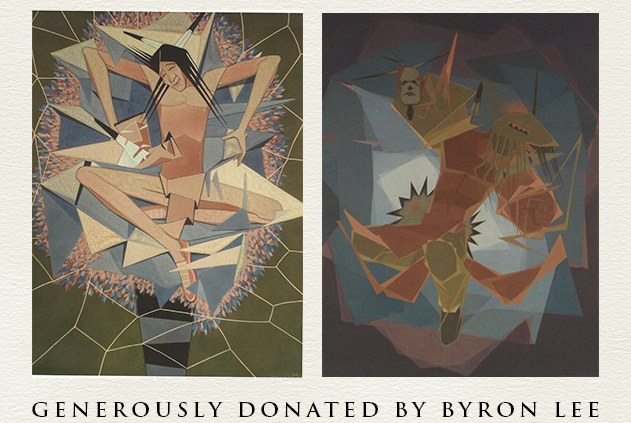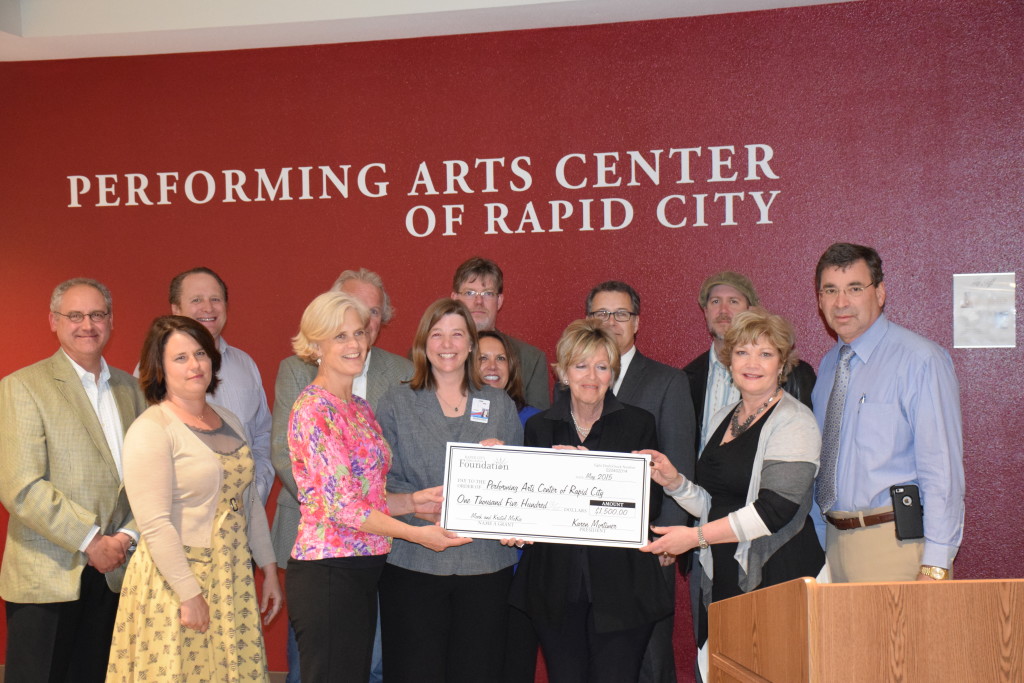The Oscar Howe Project is located in the Common Area of Rapid City High School and the Performing Arts Center of Rapid City, located at 601 Columbus Street in Rapid City, South Dakota.
If you are visiting the Performing Arts Center of Rapid City:
The Oscar Howe Project will also be available for viewings during any performance in the Historic Theater at the Performing Arts Center of Rapid City. Times and dates are subject to change. Please call the Events and Promotions Manager, Jeffrey Alan Smith, at (605) 349-6191 to schedule a visit during the after-school hours of 3:15pm – 5:00pm.
If you are visiting Rapid City High School:
The Oscar Howe Project will be available for viewing at Rapid City High School Monday – Friday from 8am – 3:15pm. Wednesday availability is subject to change due to Rapid City High School’s early release. Viewing is not allowed during the school’s lunch hour between 11:42pm and 12:46pm. In order to gain access to the building, you must first contact the Rapid City High School Administrative Office by calling ahead or visiting their office, and a visitor badge must be present while you are viewing The Oscar Howe Project. Please be aware that you will be asked to leave the building if you do not have a visitor’s pass visible on your torso. Please call the Rapid City High School office for any questions or scheduling requests at (605) 394-4048.
FOR EDUCATORS
The enclosed lessons linked to The Oscar Howe Project are not art lessons. Instead, these lessons use a significant, local installation of fine art as a catalyst to build students’ engagement with their school day and to create deeper understandings across disciplines. Their value proposition is that art is a way of making meaning and forging connections. Built on the principles of observation, reflection and original thinking, the lessons are designed to reach every student in different ways and to increase capacities for imagination and innovation.
The lessons address specific Common Core State Standards for language arts, although information from other content areas is included. Several of the lessons also address South Dakota Oceti Sakowin Essential Understandings and Standards, which contain essential learning about Lakota, Dakota, and Nakota culture.
Oscar Howe’s Artistic Legacy (grades 6-12)
This lesson uses primary source documents to engage students in learning about Oscar Howe’s many personal and professional achievements. Students read informational text, think critically about it using open-ended questions, and prepare for meaningful discussion about overcoming obstacles using the graphic organizer included.
Iktomi, The Trickster (grades K-5)
Students read informational text and primary source text from Ella Deloria’s ethnographic work Dakota Texts to learn about Iktomi, the subject of an Oscar Howe painting installed at The Performing Arts Center of Rapid City. The pairing of fine art from Howe, a Yanktonai Dakota artist, and Deloria, a scientist and writer from the same oyate, provides a strong opportunity for students to think about Iktomi and discuss the purposes Iktomi stories fulfill.
Heyokas, or Thunder Dreamers (grades 6-12)
In this lesson, students learn about Heyokas, or Thunder Dreamers, using two primary sources: Oscar Howe’s painting Heyoka Dancer and Luther Standing Bear’s writing. Students consider the serious purpose behind the humor Heyokas bring to gatherings. Critical thinking questions and a graphic organizer are included to spur student thinking.
Students read informational text and primary source text from Ella Deloria’s ethnographic work Dakota Texts to learn about Iktomi, the subject of an Oscar Howe painting installed at The Performing Arts Center of Rapid City. The lesson uses the full free translation of “Iktomi Tricks the Pheasants” from Deloria’s book, rather than the adapted version in our K-5 lesson called “Iktomi, the Trickster.” Higher-level questions and a graphic organizer on ethics round out this lesson.
Color Theory with Oscar Howe (grades 9-12+)
This lesson employs a rare transcript of Oscar Howe teaching his students about color theory! This unique primary source document is combined with informational text and high-level critical thinking questions that engage students. An original graphic organizer is included that allows students to use Oscar Howe’s instructions to create their own color wheels and prepare for discussions.
THE GIFT
Oscar Howe (Mazuha Hokshina, May 13, 1915 – October 7, 1983), a Yanktonai Dakota, is a celebrated South Dakota artist who widely influenced contemporary Native American art. Howe grew up on the Crow Creek Sioux Reservation, received a B.A. from Dakota Wesleyan University in 1952 and an M.F.A. from the University of Oklahoma in 1954. Howe was named South Dakota’s Artist Laureate in 1960 and professor of art at the University of South Dakota from 1957 to 1983.
The Oscar Howe paintings, Iktomi and Heyoka Dancer, were given to the Performing Arts Center of Rapid City in 2014 by the Lee family in honor of Evelyn Dawson Park Lee and Margaret Lee. Evelyn was the drama teacher at Rapid City High School in the 1950s and 1960s. Margaret was a friend and supporter of Oscar Howe. She and Dr. Warren M. (Doc) Lee started the Black Hills Playhouse in Custer State Park, South Dakota in 1946.
“Both of these remarkable women enriched the lives around them and understood that through the performing arts we can catch a glimpse of the things we are running from and to and why.” — Byron Lee
THE LEARNING
The Oscar Howe Project uses the tremendous gift of these two paintings as a springboard for student learning about literacy, visual art, and American Indian culture. Several self- contained lessons for K-12 students are available online to teachers and students in any community. These free lessons engage students with informational texts and primary source texts, critical thinking questions, and discussion-starters. The lessons are dual-aligned with state literacy standards and with Oceti Sakowin Essential Understandings and Standards, which contain essential learning about Dakota, Nakota, and Lakota culture.
The lessons were developed and field tested by Rapid City High School art and language teacher Gabrielle Seeley, who has extensive experience designing and delivering dual-aligned instruction. Through The Oscar Howe Project, students from any school in any community can learn about Oscar Howe, his artwork, and his culture. Teachers do not have to search for resources or purchase any materials, thanks to the commitment of our partners.
THE ARTWORK
Iktomi (eek-dó-mee) is a watercolor painting on paper, created in 1959 by Oscar Howe. The composition shows the Oceti Sakowin sacred being Iktomi, known as a spider-trickster, suspended in a “web” of pink lines. Iktomi continually plots to make people look foolish by tricking them and causing others to laugh at their folly. Mankind is warned about Iktomi’s tricks and cautioned against listening to him. Because of his desire to create trouble for others, he is friendless. Iktomi tries to make himself feel better by bringing others down, but in many Iktomi stories, he ends up hurt or being laughed at himself. In this way, stories about Iktomi teach us to behave honorably and help us avoid trouble by thinking critically about situations.
Oscar Howe’s 1965 artwork called Heyoka Dancer (hay-yó-ka) is a painting made of casein on paper. Casein is a paint made with pigment and milk proteins, used for thousands of years. The Heyoka dancer is connected to Wakinyan (wah-kéeng -yang), or Thunder. Wakinyan has two aspects: one side of him is fierce and destructive, while the other side is Heyoka, a laughter-loving clown. Heyoka dancers deliberately behave in contrary ways: they pretend to be shivering in the hot sun or say “you’re welcome” instead of “thank you.” Their contrary, even extreme behavior certainly makes people laugh, but it has a serious purpose. Wakinyan is honored most by actions and words that are the direct opposite of the person’s intent, so Heyoka dancers are paying homage to Wakinyan with their purposeful clowning. Heyoka dancers are also teachers, for they make people think about their own actions and intentions. People observing Heyoka dancers are thinking about the real intention behind the opposite behavior: the “thank you” behind the “you’re welcome.” This makes people reflect upon whether their own actions correctly reflect their intentions, and even whether those intentions are worthy.
Source: Dooling, D. M., ed. The Sons of the Wind: The Sacred Stories of the Lakota. Norman: University of Oklahoma Press, 2000.
OUR PARTNERS
The Oscar Howe Project made possible through the generosity of these Partners and Donors:
Art Donor
Byron Lee
Project Partners

Rapid City Public School Foundation
Name a Grant Program Donors
Granite Automotive
McKie Ford Lincoln
Mark & Kristol McKie
Project Donors
Byron Lee
Thomas Abell
Dr. James Maresh & Inge Howe Maresh
Project Support
Rapid City Area Schools
Prairie Edge Gallery: Guest Artist Case Curator
Arts Rapid City: Media Support & Curriculum Publication
Donald Montileaux: Advising Artist
Gabrielle Seeley: Advising Educator



